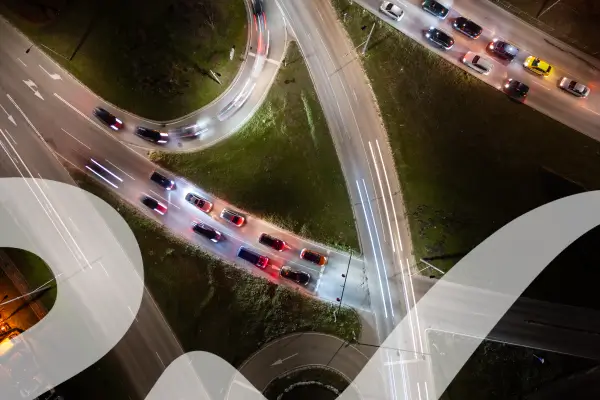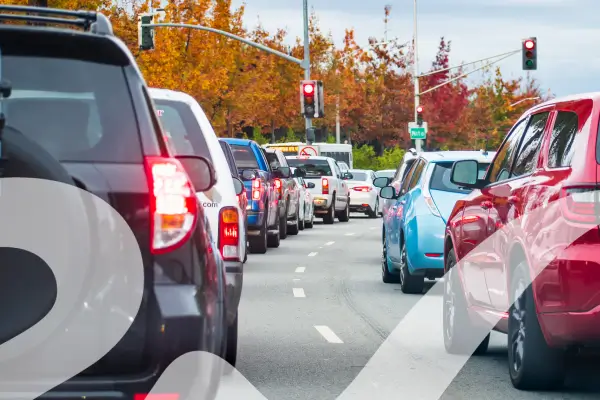Strategic transportation planning
Managing traffic efficiently: the role of data in strategic traffic planning
<p>Data analysis and data engineering play a crucial role in the field of strategic transportation planning. These approaches use historical data and current trends to predict future traffic volumes and thus form the basis for infrastructure planning and the development of sustainable mobility solutions. By systematically collecting, processing and analyzing traffic data, robust databases can be created that support comprehensive traffic models, analyses and forecasts. </p>
<p>Our solution generation support includes a range of services aimed at increasing the accuracy and effectiveness of transportation planning. From the creation of detailed traffic forecasting scenarios to the validation of traffic measures, our expertise in data analysis and engineering provides our clients with valuable support in the strategic alignment of their transportation infrastructure and services. </p>
<h2>Creation of project databases:</h2>
<h6>By systematically collecting, processing and analyzing traffic data, project databases can be created that serve as the basis for comprehensive traffic models, traffic analyses and traffic forecasts. This enables the efficient use and management of data for traffic planning. </h6>
<ul>
<li><strong>Improving traffic planning efficiency</strong>: Planning processes can be optimized and accelerated through the integration and analysis of extensive traffic data. This leads to more precise predictions and well-founded decisions. </li>
<li><strong>Increasing data quality and usability</strong>: Regular data cleansing and quality checks increase the reliability of the database, which is crucial for the accuracy of traffic models and analyses.</li>
<li><strong>Guarantee of data origin traceability</strong>: Our service ensures that the origin of all analyzed data is clearly traceable at all times. This strengthens confidence in the data analysis and makes it easier to check data sources and paths. </li>
</ul>
<p><strong>Concrete measures and services:</strong></p>
<ul>
<li><strong>Comprehensive data collection and integration for traffic modeling</strong>: Development and implementation of methods to collect a wide range of traffic data, including survey results, sensor data and traffic counts. This comprehensive data collection makes it possible to create a detailed and realistic picture of traffic behavior, which forms the basis for effective traffic modeling and analysis. </li>
<li><strong>Data cleansing and quality management</strong>: We offer services for cleansing and quality checking data to ensure its accuracy and reliability. This increases data integrity, which is essential for well-founded analyses and the derivation of valid conclusions. </li>
<li><strong>Building and managing data models</strong>: By developing complex data models that intelligently link different data sets, we can provide deeper insights into traffic flows and patterns. This helps customers to make optimal decisions for traffic planning and management. </li>
<li><strong>Implementation of project data warehousing solutions</strong>: We set up central data repositories that enable efficient integration, management and analysis of large amounts of data. This serves as a robust basis for data analysis and supports complex traffic modeling projects. </li>
</ul>
<h2>Traffic modeling:</h2>
<h6>The detailed digital simulation of real traffic systems makes it possible to simulate complex traffic movements and decisions. This enables planners to better understand how different measures affect mobility behavior. </h6>
<ul>
<li><strong>Improved traffic planning</strong>: Traffic modeling and analysis allow precise predictions to be made that support the development of efficient traffic systems. This leads to better mobility and user satisfaction. </li>
<li><strong>Reduction of congestion and environmental pollution</strong>: By optimizing traffic flows and adapting to actual needs, congestion is reduced and emissions are lowered. This contributes to a more sustainable environment. </li>
<li><strong>Promotion of sustainable means of transport</strong>: Models for choosing a means of transport enable the targeted promotion of sustainable mobility options. Customers can thus reduce environmental pollution and support social mobility goals. </li>
</ul>
<p><strong>Concrete measures and services</strong>:</p>
<ul>
<li><strong>Analytical processing of traffic data</strong>: Performing advanced analysis to process and interpret traffic data to identify trends, peak times and mobility patterns. Customers benefit from detailed insights into mobility behavior, which forms the basis for targeted traffic planning and management. </li>
<li><strong>Socio-economic data analysis</strong>: We provide detailed analysis of socio-economic data to understand influences on transport behavior. This enables targeted planning of transport infrastructure and services that meet the needs of the population. </li>
<li><strong>Creation of transport mode choice models</strong>: Development of models that enable predictions to be made about transportation choices under different conditions. Customers gain insights into how changes in the service affect users’ mobility decisions. </li>
<li><strong>Calibration of traffic models</strong>: We calibrate traffic models to increase the accuracy of simulations of real traffic systems. This improves the reliability of forecasts and supports the effective planning and optimization of traffic systems. </li>
</ul>
<h2>Transport demand analysis:</h2>
<h6>By using advanced analysis methods, traffic patterns and trends can be identified. This helps to identify bottlenecks and optimize traffic management systems to increase efficiency. </h6>
<ul>
<li><strong>Optimization of traffic infrastructure</strong>: By analysing traffic patterns, bottlenecks can be identified and targeted improvements made. This leads to a more efficient traffic flow and increased user satisfaction. </li>
<li><strong>Strategic transport planning</strong>: Elasticity tests and trend analyses provide important insights that underpin strategic decisions in transport planning and development. They enable forward-looking adaptation to future needs. </li>
<li><strong>Profitability of pay streets</strong>: Demand studies for pay streets provide essential data for pricing, maximize revenue and promote user acceptance.</li>
</ul>
<p><strong>Concrete measures and services:</strong></p>
<ul>
<li><strong>Provision of traffic pattern analyses</strong>: By using data analytics, we recognize traffic patterns and can process them for forecasting. This enables precise planning and adaptation of traffic systems to increase efficiency and fluidity. </li>
<li><strong>Elasticity tests for input parameters in the traffic model</strong>: We perform elasticity tests for key parameters in traffic models to understand how changes in these parameters affect traffic demand. This helps our clients to recognize the sensitivity of various factors and make informed decisions about traffic management and planning. </li>
<li><strong>Demand studies for pay streets</strong>: Through specialized studies, we evaluate the acceptance and willingness to pay for pay streets. This provides clients with valuable insights into potential sources of revenue and enables them to adapt pricing models accordingly. </li>
<li><strong>Conducting trend analyses in the transport sector</strong>: We analyze long-term transport trends in order to identify future challenges and opportunities in the mobility sector. These analyses support clients in the strategic planning and alignment of their transportation infrastructure and services. </li>
</ul>
<p> </p>
<h2>Traffic forecast:</h2>
<h6>Forecasting models use historical data and current trends to predict future traffic volumes. These models are crucial for infrastructure planning and the development of sustainable mobility solutions. </h6>
<ul>
<li><strong>Strategic infrastructure development</strong>: The early identification of trends through traffic forecasts enables future-oriented planning and development of transport infrastructure. This minimizes future bottlenecks and supports sustainable urbanization. </li>
<li><strong>Increased efficiency in mobility planning</strong>: In-depth analyses and validation can be used to check the effectiveness of transportation projects. This ensures targeted investment in measures that offer the greatest benefit. </li>
<li><strong>Promotion of sustainable transportation solutions</strong>: Forecasting and reviewing sustainable mobility concepts help to reduce environmental pollution. Customers can develop environmentally friendly alternatives that are viable in the long term. </li>
</ul>
<p><strong>Concrete measures and services:</strong></p>
<ul>
<li><strong>Definition and creation of traffic forecast scenarios</strong>: We define and create customized scenarios based on a variety of data and trends. This service provides clients with a solid foundation for strategic transportation and infrastructure planning to effectively meet future challenges. </li>
<li><strong>In-depth analysis of forecast scenarios</strong>: Our experts conduct comprehensive analysis on various forecast scenarios to understand their impact on the transportation system. This provides clients with insights into potential changes and enables them to make strategic decisions. </li>
<li><strong>Validation of traffic measures</strong>: We evaluate planned transportation measures in terms of their effectiveness and contribution to improving the transportation system. This helps clients to understand the rationale behind specific projects and guide investments in a targeted manner. </li>
<li><strong>Forecasting and verification of sustainable mobility concepts</strong>: We use data analytics to verify the feasibility and efficiency of sustainable mobility solutions. Customers benefit from well-founded forecasts that support the feasibility and sustainability of their mobility initiatives. </li>
</ul>
<p data-start="43" data-end="519">Strategic transport planning is inconceivable without a sound data basis. By using data analysis, traffic modelling and forecasting tools, traffic flows can be optimized, bottlenecks identified at an early stage and sustainable mobility solutions developed. The targeted use of data not only increases the efficiency of traffic planning, but also helps to reduce environmental pollution and increase the satisfaction of road users. </p>
<p data-start="521" data-end="857">Customized data collection and analysis methods can be used to create precise traffic forecasts, allowing infrastructure projects to be planned with foresight and investments to be managed in a targeted manner. The key to future-proof mobility lies in the intelligent use of data and modern analysis methods. </p>
<p data-start="521" data-end="857">Use the full potential of your traffic data! Let’s work together on an efficient and sustainable mobility strategy. Contact us for a tailor-made consultation and find out how data-driven solutions can revolutionize your transport planning. </p>





